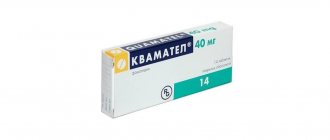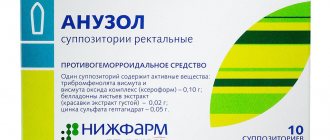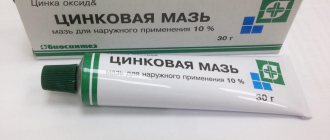Pharmacological properties of the drug L-thyroxine Berlin-Chemie
Pharmacodynamics. Synthetic levothyroxine, which is contained in the preparation L-Thyroxine 50 and 100 Berlin-Chemie, is identical in biological activity to the natural thyroid hormone. After partial conversion into liothyronine (T3), mainly in the liver and kidneys, and passage into the cells of the body, it affects the development, growth and metabolism, functional activity of the cardiovascular system and the central nervous system. Pharmacokinetics. Absorption of levothyroxine taken orally occurs mainly in the small intestine and largely depends on the galenic form of the drug - up to a maximum of 80% when taken on an empty stomach. Maximum plasma concentrations are achieved approximately 6 hours after administration. The therapeutic effect is observed 3–5 days after the start of oral administration. The volume of distribution in the body is determined at the rate of 0.5 l/kg body weight. Levothyroxine is more than 99% bound to plasma proteins. Metabolic clearance is about 1.2 liters of blood plasma per day, breakdown occurs mainly in the liver, brain tissue and muscles. Due to the high degree of binding to blood plasma proteins, thyroid hormones appear in the hemodialysate in small quantities.
Levothyroxine: do we know everything about it?
Levothyroxine is the gold standard for replacement therapy for hypothyroidism. However, in some cases, taking levothyroxine does not lead to compensation for the disease due to impaired absorption of the drug. Various factors can interfere with adequate absorption of levothyroxine, including primary or secondary lactase deficiency. The use of a lactose-free form of levothyroxine reduces the need for the drug, neutralizes the lability of hormonal parameters and, as a result, significantly improves the quality of life of patients.
Diseases of the thyroid gland occupy second place in the structure of endocrine pathology. And this primarily applies to hypothyroidism. Hypothyroidism is a condition caused by a long-term, persistent lack of thyroid hormones. According to the literature, the current prevalence of manifest hypothyroidism in the general population is 0.2–2%, and subclinical hypothyroidism is 10–12% [1]. In women, this disease occurs 6 times more often than in men [2].
Since about 10 million people today require levothyroxine replacement therapy, a doctor of any profile must know the basics of treating hypothyroidism, and also take into account the individual characteristics of the patient when choosing a drug for replacement therapy.
Levothyroxine replacement therapy
The “gold standard” of replacement therapy for hypothyroidism is levothyroxine. The thyroid gland practically does not perform other functions except secretory. The synthesis of hormones by the thyroid gland is not related to the circadian rhythm. Therefore, a daily single dose of levothyroxine in a dose that replenishes the hormone deficiency helps maintain normal thyroid function.
Synthetic levothyroxine preparations appeared back in the 50s. last century. There is a sufficient number of studies confirming that levothyroxine is the best available drug for the treatment of hypothyroidism [3]. However, new studies on the effectiveness of levothyroxine replacement therapy are emerging, expanding the possibilities of its use.
One recent cross-sectional study conducted in Pakistan examined the detection of hypothyroidism in newborns. The criterion is the level of thyroid-stimulating hormone (TSH). If hypothyroidism was detected, treatment with levothyroxine was prescribed. Of 550 newborns, 4 (0.8%) had elevated TSH levels. Congenital hypothyroidism had a statistically significant relationship with maternal hypothyroidism (p = 0.0001) and her taking levothyroxine during pregnancy (p = 0.013) [4].
A population-based study conducted in the Netherlands proved the connection between patient age and decreased thyroid function. From 2002 to 2003, 5816 people of different ages without previously identified thyroid diseases took part in it. The mortality rate among older adults with TSH levels of 3.0–4.0 mIU/L was significantly higher than among patients with TSH levels in the intermediate range of 1.0–2.0 mIU/L (HR 1.8 (95 % CI 1.0–3.1)). The authors suggested that there was the potential for levothyroxine replacement therapy in such patients [5].
A meta-analysis conducted in Kuwait showed that suppressive therapy with levothyroxine for solitary thyroid nodules helps to reduce the size of the nodes by 2 times and reduces the risk of cancer by 50%. Thus, it has been proposed to consider this type of treatment as an alternative in patients receiving levothyroxine, but on the condition that the risk of side effects in such patients is minimal [6]. However, the clinical effectiveness and safety of such therapy are still controversial.
At present, we can confidently say that the indication for the use of levothyroxine is not only hypothyroidism of various origins (including during pregnancy, lactation, and also when planning pregnancy [7]), but also mixed goiter. The drug is prescribed as part of complex therapy for diffuse toxic goiter (after achieving a euthyroid state), euthyroid hyperplasia of the thyroid gland, for the prevention of relapses after surgical treatment of nodular and malignant neoplasms of the thyroid gland, and for cretinism. Levothyroxine is also recommended for use when testing for thyroid suppression.
The half-life of levothyroxine is quite long - 6-7 days. About 15% is excreted by the kidneys and bile (unchanged and in the form of conjugates). The bioavailability of the drug when taken orally is quite high. After taking levothyroxine, 48 to 79% of the drug is absorbed from the gastrointestinal tract (GIT). Taking on an empty stomach increases the absorption of the active substance. The maximum concentration in blood plasma is reached after approximately 6 hours. Binding to plasma proteins (thyroxine-binding globulin, prealbumin and albumin) is 99%. Volume of distribution – 0.5 l/kg. Distribution occurs mainly in the liver, brain and muscles. Monodeiodination (approximately 80% of levothyroxine sodium) occurs in various tissues to form triiodothyronine and inactive products. A small amount of the active substance undergoes deamination and decarboxylation to form tetraiodothyroacetic acid, as well as conjugation with sulfuric and glucuronic acids (in the liver).
The replacement dose of levothyroxine for primary hypothyroidism in adults is determined at the rate of 1.6 mcg/kg of the patient’s body weight. With age, the need for the drug sometimes decreases, and the dose of levothyroxine can be reduced to 1 mcg/kg. In overweight patients, the dose is calculated per 1 kg of ideal body weight. Previously, most researchers recommended increasing the dose to a full replacement gradually - over 2-4 weeks, while starting treatment with 50 mcg of the drug, increasing the dose by 25 mcg. However, recent evidence suggests that it is safe to initiate treatment at the full replacement dose in patients without cardiovascular disease and under age 50 years. In the presence of cardiovascular diseases, the initial dose should be 12.5–25 mcg, and then gradually increase.
If hypothyroidism is first detected during pregnancy, levothyroxine is prescribed at a full replacement dose. It should be taken into account that during pregnancy the need for levothyroxine increases significantly and the total replacement dose will be about 2.3 mcg/kg [8].
Endocrinologists at the US Children's National Medical Center (Washington) analyzed the results of treatment of 55 patients with congenital hypothyroidism over 3 years. The patients were divided into three groups depending on the dose of levothyroxine received: the first group – 6–9.9 mcg/kg, the second – 10–11.9 mcg/kg and the third – 12–15 mcg/kg. The overdose criterion is thyroxine levels > 16 mcg/dl, free thyroxine > 2.3 ng/dl and TSH 6 mIU/l after a month. The level of thyroid hormones that meets the criteria for conditions such as euthyroidism, hyperthyroidism and thyrotoxicosis, after a month, was noted in the first group in 46, 37 and 17% of patients, respectively, in the second - in 30, 55 and 15% of patients, in the third - in 0 , 75 and 25% of patients. The authors concluded that at the time of diagnosis, initial doses of levothyroxine are 10–11.9 mcg/kg (TSH level > 100 mIU/L) and 8–10 mcg/kg (TSH level
Causes of decompensation of hypothyroidism
Oral levothyroxine in doses that provide hormonal balance is the most convenient form for treating hypothyroidism. However, one third of patients receiving levothyroxine replacement therapy experience decompensated hypothyroidism [10].
OE Okosieme et al., having studied 58,567 medical records, identified a group of patients with hypothyroidism (n = 1037) treated with levothyroxine in UK hospitals from 2004 to 2009. The researchers noted that 385 (37.2%) patients did not achieve target TSH levels. An analysis of controlled and cohort studies, as well as systematic reviews published since 1960 and devoted to the problem of uncompensated hypothyroidism, showed that in 50% of cases, levothyroxine replacement therapy does not allow achieving the target TSH level [11].
Malabsorption
The fact is that various factors can influence decreased absorption of levothyroxine. The most common cause of failure or resistance to levothyroxine treatment is pseudomalabsorption syndrome.
Already in 2006, M. Muñoz-Torres et al. stated that the cause of resistance to levothyroxine therapy in a 55-year-old patient was previously undiagnosed lactose intolerance. Researchers have suggested that 7–20% of the adult population is lactose intolerant
is the cause of impaired bioavailability of levothyroxine, which is apparently associated with the presence of gastrointestinal diseases. According to the authors, this pathology can be corrected with the help of diet [12]. This is confirmed by recent work.
Turkish scientists conducted a study of 83 patients with autoimmune thyroiditis (Hashimoto's thyroiditis) complicated by hypothyroidism. All patients took levothyroxine. A test for lactose intolerance showed its presence in 75.9% of patients. The final analysis included 38 subjects with lactose intolerance (30 patients in euthyroid status and 8 with subclinical hypothyroidism) and 12 subjects without this pathology. Patients with lactose intolerance were on a lactose-free diet. Observation lasted 8 weeks. The results showed a significant decrease in TSH levels in patients with lactose intolerance: in euthyroid patients - from 2.06 ± 1.02 to 1.51 ± 1.1 mU/ml, in patients with subclinical hypothyroidism - from 5.45 ± 0.74 to 2.25 ± 1.88 mU/ml, respectively (p 0.05). The authors concluded that lactose intolerance is common in patients with autoimmune thyroiditis, and reducing lactose intake reduces TSH levels. Therefore, patients with hypothyroidism who require increasing doses of levothyroxine and who have unstable TSH levels and are resistant to thyroxine treatment should be evaluated for lactose intolerance [13].
The effectiveness of levothyroxine therapy in patients with lactose intolerance was assessed in a study conducted in Rome. It involved 34 patients with autoimmune thyroiditis and hypothyroidism. The work was carried out from 2009 to 2012. A prerequisite for the study was adherence to a lactose-free diet.
In all patients with autoimmune thyroiditis with good lactose tolerance, stabilization of TSH (median TSH - 1.02 mU/l) was achieved with an average dose of levothyroxine 1.31 mcg/kg per day. With the same dose of the drug (1.29 mcg/kg per day) in patients with lactose intolerance, only 5 out of 34 patients achieved the target TSH level (median TSH - 0.83 mU/l). For the remaining 29 patients, the dose of levothyroxine was gradually increased: the target TSH level (median TSH - 1.21 mU/l) was achieved with an average levothyroxine dose of 1.81 mcg/kg per day (+38%, p
Lactose intolerance is a pathological condition caused by a decrease in lactase levels. Lactase deficiency is encoded by a single gene (LCT) located on chromosome 2q21. Lactase is an enzyme necessary to break down lactose. It has been observed that lactase activity decreases upon transition to an adult diet. In Northern Europeans, lactose intolerance usually develops after age 20 [15]. The frequency of constitutional lactase deficiency in the population also depends on ethnicity [16]. Some studies have shown that in northern regions lactose intolerance occurs in 35% of the population [17].
Lactase deficiency manifests itself in the form of osmotic diarrhea and increased gas formation in the intestines. The severity of symptoms depends on the level of enzyme production, the characteristics of the intestinal biocenosis, as well as the amount of lactose entering the body.
By eliminating foods containing lactose from your diet (which is not an easy task), you can reduce the severity of symptoms or even eliminate this disorder [18].
Lactase deficiency can be primary (hereditary) and secondary (damage to the mucous membrane of the small intestine by infectious agents, toxins, drugs, or as a result of surgical operations on the gastrointestinal tract) [19].
Possible damage to the mucous membrane of the small intestine, leading to irreversible lactose intolerance, has been described with the use of neomycin and kanamycin, colchicine, aminosalicylic acid and antineoplastic agents.
Cases of clinical symptoms of lactase deficiency in patients receiving drugs containing lactose as an excipient have been described with the use of flutamide, lithium carbonate, tranylcypromine, cromolyn sodium and acyclovir [20].
Therefore, if a patient with hypothyroidism has confirmed lactose intolerance, it is necessary to either prescribe a lactose-free diet or use lactose-free levothyroxine.
Another factor that prevents adequate absorption of levothyroxine is non-compliance with the drug dosage regimen.
, for example, changing the interval between taking the drug and eating. In patients with persistently high TSH levels who require more than 2 mcg/kg levothyroxine per day, inappropriate use of levothyroxine should first be excluded and only then examined for the presence of the pathology in question.
Gastrointestinal diseases
. A decrease in bioavailability can be affected by the presence of celiac disease in patients, inflammatory diseases of the gastrointestinal tract and parasitic infestation, intestinal resection, as well as atrophic gastritis and Helicobacter pylori infection.
It has been shown that in patients who have undergone surgical interventions on the gastrointestinal tract, the dose of levothyroxine is usually higher than that ensuring the achievement of euthyroidism in normal cases [21].
A gluten-free diet for celiac disease, as a rule, allows you to stabilize the dose of levothyroxine, a similar effect is achieved as a result of eliminating Helicobacter pylori infection or parasitic infestation. In cases of atrophic gastritis or the development of inflammatory processes in the intestines, treatment of the disease and restoration of the normal state of the gastrointestinal tract can increase the absorption of the drug.
The normal metabolism of levothyroxine is interfered with by certain foods, dietary fiber and coffee.
.
Many drugs
, such as cholic acid, ferrous sulfate, sucralfate, calcium carbonate, aluminum-containing antacids, phosphate binders, raloxifene, proton pump inhibitors, also negatively affect the absorption of levothyroxine [22].
Reduced activity of the active substance
Different excipients have different effects on the stability of levothyroxine sodium. The activity of levothyroxine, which contains lactose, decreases more rapidly during storage than the activity of levothyroxine made using dibasic calcium phosphate. Thus, tablet forms of the drug, which use lactose as an excipient, no longer meet the requirements of the United States Pharmacopeia (USP) after 3 months of storage at a temperature of 40 ° C and a relative humidity of 75%. Under the same storage conditions, the decrease in the activity of levothyroxine sodium in a preparation produced using dibasic calcium phosphate was only 15% [23].
Modern drugs of levothyroxine
In order to improve the tolerability and safety profile of its drugs, it decided to exclude lactose from the excipients used in the production of levothyroxine. Dibasic calcium phosphate was used as a filler. An example of such a drug is L-Thyroxine Berlin-Chemie. Taking it allows you to reduce the dose of the drug and achieve target TSH values in patients with hypothyroidism and concomitant lactose intolerance. This makes the treatment of hypothyroidism safer and more effective and opens up broad prospects for the use of the drug L-Thyroxine Berlin-Chemie.
Use of the drug L-thyroxine Berlin-Chemie
The daily dose of the drug is set individually based on clinical and laboratory examination data. If residual thyroid function is preserved, the dose of replacement therapy may be slightly lower than usually prescribed. Particular caution is required when starting treatment with thyroid hormones in elderly patients, with coronary artery disease, severe hypothyroidism, or in cases where decreased thyroid function has been observed for a long time. In these cases, it is necessary to choose a lower initial dose and gradually increase it with frequent monitoring of thyroid hormone levels. In case of insufficient body weight and the presence of a large nodular goiter, a low dose is sufficient. Unless otherwise prescribed, the following dosage recommendations exist: Adults Hypothyroidism. The initial dose is 25–50 mcg/day, maintenance dose is 100–200 mcg/day (the dose is increased by 25–50 mcg at intervals of 2–4 weeks). Prevention of goiter relapse: 75–200 mcg/day. Benign goiter with a euthyroid state of function: 75–200 mcg/day. Concomitant therapy in the treatment of hyperthyroidism with thyrestatics - 50–100 mcg/day. Children. The starting dose for children is 12.5-50 mcg, and for infants - 25-50 mcg. When prescribing a replacement dose during long-term therapy, the child’s age and body weight are taken into account, among other indicators. The following are approximately recommended doses:
Age | Dosage, mcg/day | Dosage, mcg/kg/day |
| 0–6 months | 25–50 | 10–15 |
| 6–24 months | 50–75 | 8–10 |
| 2–10 years | 75–125 | 4–6 |
| 10–16 years | 100–200 | 3–4 |
| 16 years | 100–200 | 2–3 |
Due to the special shape of the tablet, it can be divided by placing the tablet on a hard surface with the division notch facing upward and pressing it with your finger from above in a perpendicular direction. The daily dose is taken once in the morning on an empty stomach at least 30 minutes before meals. The tablets are taken without chewing and washed down with a small amount of water (1/2 cup). For infants, the daily dose is prescribed no later than 30 minutes before the first feeding. To do this, the tablets are dissolved in a small amount of water, and the resulting mixture (prepare immediately before use!) is given along with a small amount of liquid. Duration of therapy: for hypothyroidism, in most cases, throughout life; in the treatment of euthyroid goiter, as well as for the purpose of preventing goiter relapse - from several months, years and until the end of life; as concomitant therapy in the treatment of hyperthyroidism - depending on the duration of administration of the thyreostatic agent.
Indications for Thyroxine
As a rule, Thyroxine is included in the basis of hormonal replacement treatment for decreased thyroid function. In addition, taking the medicine is relevant for the following conditions:
- Hypothyroidism of various origins.
- Excess body weight and pronounced signs of cretinism, provoking the appearance of thyroid hypothyroidism.
- Cerebral-pituitary pathological conditions.
- Prevention of the occurrence of nodular goiter due to surgery on the organ.
- Therapy of diffuse goiter.
- Treatment of malignant tumor of the thyroid gland.
- Graves pathology.
- Euthyroid proliferation of the gland.
Side effects of the drug L-thyroxine Berlin-Chemie
When using the drug, tachycardia, increased heart rate, arrhythmia, angina pectoris, tremor, a feeling of internal restlessness, insomnia, hyperhidrosis, a feeling of heat, increased body temperature, weight loss, vomiting, diarrhea, headache, weakness and muscle spasms, menstrual irregularities may occur. . If these symptoms appear, it is recommended to reduce the daily dose or interrupt the drug for several days. As soon as the side effects disappear, you can return to treatment again, carefully increasing the dosage of the drug. Allergic reactions may occur in the form of urticaria, bronchospasm and laryngeal edema, and in some cases, anaphylactic shock.
Special instructions for the use of the drug L-thyroxine Berlin-Chemie
Before starting therapy with thyroid hormones, the patient should exclude the presence of coronary artery disease (angina), hypertension (arterial hypertension), pituitary insufficiency, adrenal insufficiency, thyroid autonomy and/or treat them accordingly. In case of coronary artery disease, heart failure or tachyarrhythmia, arrhythmias, even a mild form of hyperthyroidism is unacceptable. For patients at risk (patients with coronary artery disease, hypertension (arterial hypertension), tachyarrhythmia, chronic heart failure, insufficiency of the pituitary gland or adrenal cortex, autonomy of the thyroid gland), the drug is prescribed with extreme caution only after preliminary treatment of this pathology and under constant frequent monitoring of thyroid hormone levels glands. In case of secondary hypothyroidism, the presence of concomitant adrenal insufficiency should be excluded. If this condition is confirmed, it is necessary to first treat with corticosteroids (hydrocortisone). If thyroid autonomy is suspected, it is recommended to determine the TSH level and conduct suppression scintigraphy. When using levothyroxine for the treatment of hypothyroidism in women during menopause who have an increased risk of osteoporosis, in order to prevent the level of levothyroxine in the blood from exceeding the physiological norm, more frequent monitoring of thyroid function should be carried out. Use during pregnancy and lactation. Treatment with thyroid hormones must be carried out consistently, especially during pregnancy and breastfeeding. Despite the widespread use of the drug during pregnancy, the presence of danger to the fetus is still not known. The amount of thyroid hormone that passes into milk during breastfeeding, even with high-dose thyroid hormone therapy, is insufficient to cause hyperthyroidism or suppression of TSH secretion in infants. During pregnancy, patients with hypothyroidism may have an increased need for levothyroxine, which is caused by estrogens, so thyroid function should be monitored both during pregnancy and after, and, if necessary, dose adjustment of replacement therapy should be carried out. During pregnancy, the use of levothyroxine for concomitant treatment of hyperthyroidism with thyreostatic drugs is contraindicated, since this requires a higher dose of thyreostatic drugs. Thyrostatic drugs, unlike levothyroxine, penetrate the placental barrier in significant doses, which can cause the development of fetal hypothyroidism. In this regard, in the presence of hyperthyroidism during pregnancy, monotherapy with thyreostatic drugs in low doses is recommended. During pregnancy, thyroid tests using suppression should be avoided. Use in children. With congenital hypothyroidism, timely initiation of treatment is a decisive factor for the normal psychomotor development of the child. In the first 3–4 years of life, T4 levels should be brought to the upper limit of normal. In the first 6 months of life, a more reliable control is to measure the T4 level than the TSH level. In some cases, normalization of TSH levels, despite sufficient T4 levels, can take up to 2 years. More detailed information is provided in the APPLICATION section. The ability to influence reaction speed when driving vehicles or working with other mechanisms . Not known.
Interactions of the drug L-thyroxine Berlin-Chemie
In the case of combined use of levothyroxine with cholestyramine or colestipol, an interval of 4–5 hours should be maintained between their doses (cholestyramine/colestipol inhibits the absorption of levothyroxine). The absorption of levothyroxine may be reduced by concomitant use of aluminum-containing antacids, calcium carbonate or iron-containing drugs, so it should be taken at least 2 hours before taking these drugs. Propylthiouracil, corticosteroids, β-adrenergic receptor blockers and iodine-containing contrast agents inhibit the conversion of T4 to T3. Amiodarone, due to its high iodine content, can cause both hypothyroidism and hyperthyroidism. Particular care should be taken in case of nodular goiter with the possibility of unrecognized autonomy. Rapid intravenous administration of phenytoin can lead to an increase in the plasma concentration of free levothyroxine, liothyronine and, in some cases, provoke the appearance of cardiac arrhythmias. Under the influence of furosemide in high (250 mg) doses, as well as salicylates, dicumarol, clofibrate, levothyroxine may be displaced from the sites of its binding to blood plasma proteins and, as a result, its action may be enhanced. Sertraline and chloroquine/proguanil reduce the effectiveness of levothyroxine and increase serum TSH levels. During the use of contraceptives containing estrogens or during postmenopausal hormone therapy, the need for levothyroxine may increase. Products containing soy may reduce the intestinal absorption of levothyroxine, which may require dose adjustment. Under the influence of levothyroxine, a decrease in the hypoglycemic effect of insulin and oral antidiabetic drugs may occur. For this reason, in patients with diabetes mellitus using levothyroxine, regular monitoring of blood sugar levels is necessary (especially at the beginning of therapy), and, if necessary, dosage adjustment of antidiabetic drugs. Levothyroxine may enhance the effect of coumarin derivatives, therefore, when used simultaneously, regular monitoring of blood clotting is necessary, and, if necessary, dose adjustment of the anticoagulant drug.
Overdose of the drug L-thyroxine Berlin-Chemie
In case of overdose, an accelerated pulse, increased heartbeat, sweating, arrhythmia, insomnia, tremor, increased frequency of angina attacks, and worsening of diabetes mellitus are noted. It is recommended to stop taking the pills and conduct follow-up examinations. If severe tachycardia develops, it can be weakened with the help of β-adrenergic receptor blockers; thyreostatic agents are not used. When taking levothyroxine in a very high dose (suicide attempt), plasmaphoresis is used.
Levothyroxine sodium overdose, symptoms and treatment
Accompanied by symptoms of hyperthyroidism (weight loss, palpitations, sinus tachycardia, arrhythmia, angina pectoris, heart failure, tremor, headache, insomnia, heat intolerance, fever, irritability, diarrhea, abdominal pain); increased levels of T3 and T4 in the blood serum and free thyroxine index. Depending on the severity of symptoms, it is recommended to reduce the dose or temporarily discontinue levothyroxine. If clinical symptoms are pronounced, the stomach is washed, cholestyramine, β-adrenergic receptor blockers are prescribed, and oxygen therapy is performed. Thyrostatic drugs are not used. In case of acute poisoning (suicide attempt), plasmapheresis is recommended.
List of pharmacies where you can buy Levothyroxine sodium:
- Moscow
- Saint Petersburg








